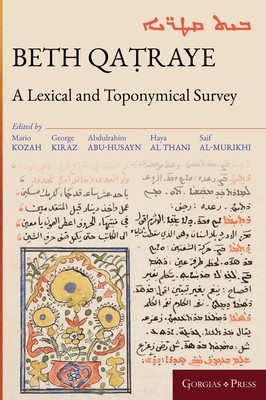
- We will send in 10–14 business days.
- Author: Mario Kozah
- Publisher: Gorgias Press
- Year: 2021
- Pages: 462
- ISBN-10: 1463241399
- ISBN-13: 9781463241391
- Format: 17.8 x 25.4 x 2.5 cm, hardcover
- Language: English
- SAVE -10% with code: EXTRA
Reviews
Description
Beth Qaṭraye, Syriac for "region of the Qataris," is a term found in Syriac literature referring to the region of north-eastern Arabia, including modern-day Qatar and Bahrain, from the fourth to the ninth centuries. Beth Qaṭraye was an important cultural, linguistic and religious crossroads in the pre-Islamic and early Islamic period, when it produced a number of important East-Syriac authors. Scholarship has so far only focused on these Syriac authors and their writings rather than other aspects of Beth Qaṭraye. This volume presents and analyzes information on the pre-Islamic and early Islamic historical geography and toponyms of the Beth Qaṭraye region as well as newly discovered vocabulary from a language referred to as Qaṭrāyīth ("in Qatari") used by its inhabitants. Based on analysis of this new data, Mario Kozah argues that Qaṭrāyīth is in fact a local Arabic dialect transliterated using Syriac letters. Thus, Qaṭrāyīth consists mostly of Arabic vocabulary (as well as a few Syriac and Pahlavi loanwords), and maintains mainly Arabic with some Syriac grammatical structures and lexical influence. As such, it constitutes the oldest documented Arabic vernacular from the seventh-century Arabian Peninsula, revealing a language in rapid transformation. The volume also includes a special chapter on the islands of the Gulf region according to Muslim sources by Saif Al-Murikhi and a unique reconstruction of the lexicon of Ḥenanishoʿ bar Seroshway (ca. 900) by George Kiraz.
EXTRA 10 % discount with code: EXTRA
The promotion ends in 19d.18:09:15
The discount code is valid when purchasing from 10 €. Discounts do not stack.
- Author: Mario Kozah
- Publisher: Gorgias Press
- Year: 2021
- Pages: 462
- ISBN-10: 1463241399
- ISBN-13: 9781463241391
- Format: 17.8 x 25.4 x 2.5 cm, hardcover
- Language: English English
Beth Qaṭraye, Syriac for "region of the Qataris," is a term found in Syriac literature referring to the region of north-eastern Arabia, including modern-day Qatar and Bahrain, from the fourth to the ninth centuries. Beth Qaṭraye was an important cultural, linguistic and religious crossroads in the pre-Islamic and early Islamic period, when it produced a number of important East-Syriac authors. Scholarship has so far only focused on these Syriac authors and their writings rather than other aspects of Beth Qaṭraye. This volume presents and analyzes information on the pre-Islamic and early Islamic historical geography and toponyms of the Beth Qaṭraye region as well as newly discovered vocabulary from a language referred to as Qaṭrāyīth ("in Qatari") used by its inhabitants. Based on analysis of this new data, Mario Kozah argues that Qaṭrāyīth is in fact a local Arabic dialect transliterated using Syriac letters. Thus, Qaṭrāyīth consists mostly of Arabic vocabulary (as well as a few Syriac and Pahlavi loanwords), and maintains mainly Arabic with some Syriac grammatical structures and lexical influence. As such, it constitutes the oldest documented Arabic vernacular from the seventh-century Arabian Peninsula, revealing a language in rapid transformation. The volume also includes a special chapter on the islands of the Gulf region according to Muslim sources by Saif Al-Murikhi and a unique reconstruction of the lexicon of Ḥenanishoʿ bar Seroshway (ca. 900) by George Kiraz.


Reviews